On August 27, 2003 Mars was as close as it has been or will be over a period of about 60,000 years. Needless to say, this was a lifetime opportunity for Mars observers and imagers. As the technology of imaging keeps getting better, the images by even novice amateurs, armed with small telescopes and webcams, have been truly amazing.
My best images are posted on this page and comparing these to what I have done during previous oppositions Mars speak for themselves.
Much to my disappointment, seeing conditions have recently been such that I have not taken a decent image since the end of August. I suspect this is related to the fact that Mars was on the Meridian well after midnight and now it is there shortly after dark. It seems that the chances of good seeing conditions improve in the wee hours and the stability of the atmosphere is at its worst in the early part of the night.
The conflict is that the best imaging and viewing is possible only when Mars is at it's highest in the sky and this occurs earlier every night. It is now setting in the west at the time I was taking images a few months ago.
I will not give up checking every night but it just may turn out that what you see is what I got.
With that in mind, I have taken the best 6 images I acquired and converted them to monochorme, adjusted them to the same size and combined them with a map of Mars created by the Association of Lunar and Planetary Observers (ALPO).
The lines point to the most obvious features in each image. The images are organized to display the complete rotation of the planet but due to the inability to always get a good picture on the night when the particular feature was visible, they are not in any particular date sequence and the dates are only for historical purposes.

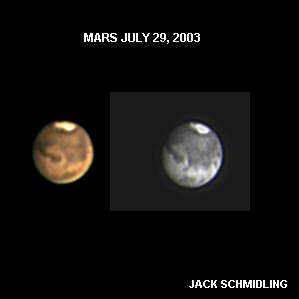
Mars July 29, 2003
These images were taken on a night of relatively good seeing (5/10) for my location.
The color image was taken with the MX5C one shot color camera and is a stack of 5 images.
The monochrome image was taken with the MX716 camera and is a stack of 7 images.
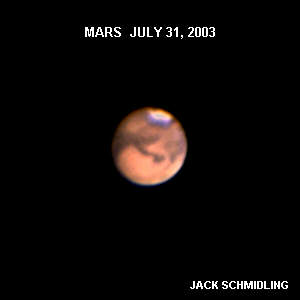
Mars July 31, 2003
This image was taken on a night when the seeing was not as good (4/10) as the above.
It was acquired with a web cam and consists of the best of 150 frames.
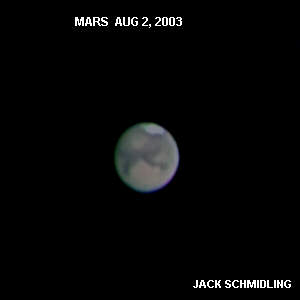
Mars August 02, 2003
This image was taken on a night of poor seeing, about 3/10.
It was taken with the MX716 camera through RGB filters and a stack of 10 monochrome images for the luminance.
It was my first attempt at LRGB color on Mars and considering the lousy seeing, I got more than I expected.
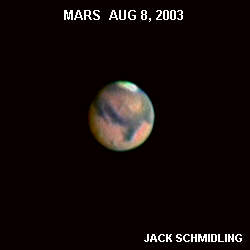
Mars August 8, 2003
This image expands on the technique used to produce the last picture of the previous sequence. It is a standard LRGB composite taken with the MX716 camer and an RGB filter set.
I have pretty much abandoned the one-shot color camera and the web camera in favor of the much superior LRGB process and monochrome CCD camera.
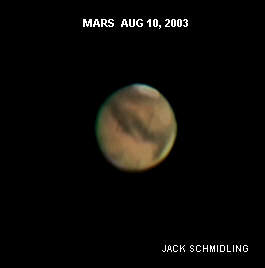
Mars August 10, 2003
This image was taken using the same process as above.
The magnification was increased to produce a slightly larger image.
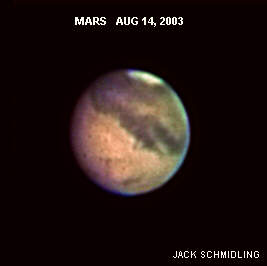
Mars August 14, 2003
This image utilized a new technique that produces a much larger image with little or no loss of resolution.
The magnification was increased to about double that of the previous or about 11X. The image was acquired in the 2
x 2 binned mode which produces an image on screen of half the size of the normal resolution mode. Contrary to what seems obvious, this actually produces a higher resolution image. The technique of course, only applies to planetary imaging.
The exposure times used were .05 sec for luminance and .1 second for RGB. Telescope in all cases is the 16" Newtonian.
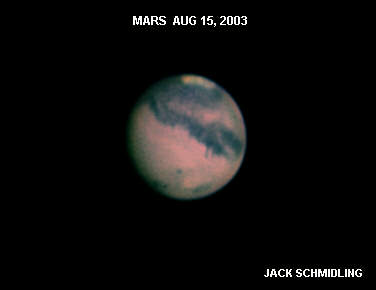
Mars August 15, 2003
This image was taken using the same process as above with a new variation.
I have always noticed that Mars looked better both visually and on images when seen through a red filter. I therefore took the lum images using a red filter instead of none and not only got better monochrome images for the luminence but could use the same image for the Red thus eliminating one step in the RGB process.
The process is known as RRGB and apparently I did not invent it.
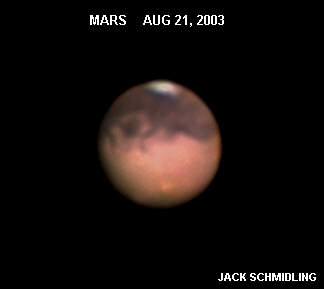
Mars August 21, 2003
The seeing was not as good on this night but I did manage to get a more natural color using the RRGB technique described above.
This ends Chapter 2. Hopefully, I will have a few more nights of good seeing before Mars heads back into the hinterland.
MARS
SWAN SONG
I don't know if it was worth waiting 66,000 years for this apparition but comparing an image taken this past week to one taken when Mars was at it's closest, is certainly one way to appreciate the wonderful opportunity that has just passed.
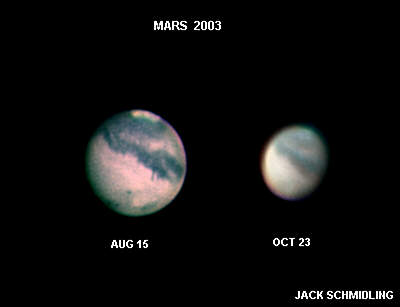
MARS Oct 23, 2003
The image on the right was taken at exactly the same magnification as the earlier ones so the dramatic difference in size truly represents the distance Mars has moved away from us in just a matter of 2 months.
Seeing conditions were much better during the first image also but the difference in size alone tells much of the story of future prospects for observing Mars.
For more images, including one taken through the venerable Yerkes 40"
and to get a perspective on how
technology has changed, see:
MARS
PHOTO INDEX
ASTRONOMY PAGE
HOME PAGE










